Day-127 | Daily MCQs | UPSC Prelims | GEOGRAPHY
[WpProQuiz 137]
[WpProQuiz 137]
THE CONTEXT: The Election Commission of India reduced the notice period from 30 days to seven
days for registration of political parties under Section 29A of the Representation of the People Act,
1951, in view of the ongoing third wave of the Covid-19 pandemic.
THE EXPLANATION:
Why registering with the EC is important?
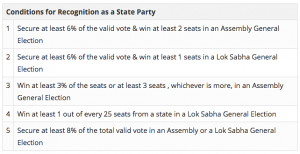
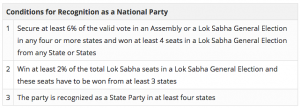
THE CONTEXT: According to the official data, two-way trade between India and China in 2021 stood
at $125.66 billion, up 43.3% from 2020 when bilateral trade was worth $87.6 billion.
THE EXPLANATION:
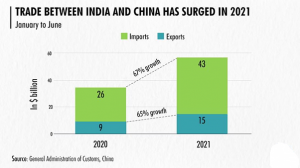
THE CONTEXT: Local farmers residing nearby area’s of kolleru lake, practicing Aquaculture in large scale
leads to local carp and shrimp industry expanded, the fish ponds to harvest them have been built farther
into the lake, and the water has been severely degraded.
THE EXPLANATION:
About Kolleru Lake and Aquaculture :
THE CONTEXT: The BrahMos, the supersonic cruise missile system jointly made by India and Russia,
has been selected by the Philippines under a $374.96 million deal, making it the first export order
for the missile.
THE EXPLANATION:
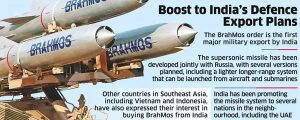
About the Missile:
Characteristics of BrahMos
Missile Technology Control Regime (MTCR)
India became a member of MTCR in 2016. With this partnership, India and Russia are planning to
develop a new generation of Brahmos missiles with a range of 800 km-plus. It has the ability to hit
protected targets with pinpoint accuracy.
THE CONTEXT: An underwater volcano near Tonga has erupted for the third time in January 2021
potentially threatening the ability of surveillance flights to assess the damage to the Pacific island
nation.
THE EXPLANATION:
According to Australia's meteorological service eruption was likely the biggest recorded anywhere
on the planet in more than 30 years, according to experts. Dramatic images from space captured
the eruption in real time, as a huge plume of ash, gas and steam was spewed up to 20 kilometers
(12.4 miles) into the atmosphere — and tsunami waves were sent crashing across the Pacific.
Where is Tonga's Hunga-Tonga-Hunga-Ha'apai volcano?

Where did the tsunami hit?
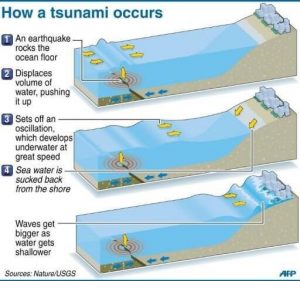
Q1. Vitamin-D plays vital role in which of the following?
1. Metabolic functions
2. Bone health
3. Immune system
4. Mental health
Select the correct answer using code given below:
a) 1 and 2 only
b) 2 and 3 only
c) 2, 3 and 4 only
d) All of them
Answer: b)
Explanation:
1. Nuakhai – Odisha
2. Wangala – Garo, Meghalaya
3. Bihu – Assam
4. Onam – Kerala
POLITY AND GOVERNANCE
INTERNATIONAL ISSUES
ECONOMIC DEVELOPMENT
ENVIRONMENT AND ECOLOGY
ETHICS EXAMPLES AND CASE STUDY
QUOTATIONS AND CAPTIONS
Things to Remember:
THE CONTEXT: Niti Aayog in its report on multi-dimensional poverty in India attempted for the first time to look at the poverty issue through a holistic perspective rather than the sole prism of income. This article lets us understand the state of multi-dimensional poverty in India and how India can overcome it.
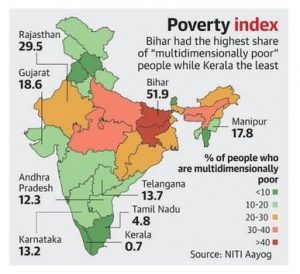
METHODOLOGY OF THE REPORT
DIMENSION: Health
WEIGHT: 1/3
INDICATOR (WEIGHT): Nutrition (1/6)
DEPRIVED OF: A household is considered deprived if any child between the ages of 0 to 59 months, or woman between the ages of 15 to 49 years, or man between the ages of 15 to 54 years -for whom nutritional information is available- is found to be undernourished.
INDICATOR (WEIGHT): Child Adolescent Mortality (1/12)
DEPRIVED OF: A household is deprived if any child or adolescent under 18 years of age has died in the household in the five-year period preceding the survey.
INDICATOR (WEIGHT): Maternal Health (1/12)
DEPRIVED OF: A household is deprived if any woman in the household who has given birth in the 5 years preceding the survey has not received at least 4 antenatal care visits for the most recent birth or has not received assistance from trained skilled medical personnel during the most recent childbirth.
DIMENSION: Education
WEIGHT: 1/3
INDICATOR (WEIGHT): Years of Schooling (1/6)
DEPRIVED OF: A household is deprived if not even one member of the household aged 10 years or older has completed six years of schooling.
INDICATOR (WEIGHT): School Attendance (1/6)
DEPRIVED OF: A household is deprived if any school-aged child is not attending school up to the age at which he/she would complete class 8.
INDICATOR (WEIGHT): Cooking Fuel (1/21)
DEPRIVED OF: A household is deprived if the primary source of cooking fuel is dung, agricultural crops, shrubs, wood, charcoal or coal.
INDICATOR (WEIGHT): Sanitation (1/21)
DEPRIVED OF: The household has unimproved or no sanitation facility or it is improved but shared with other households.
INDICATOR (WEIGHT): Drinking-Water (1/21)
DEPRIVED OF: A household is deprived if it does not have access to improved drinking water or safe drinking water is more than a 30-minute walk from home (as a round trip).
DIMENSION: Standard of Living
WEIGHT: 1/3
INDICATOR (WEIGHT): Electricity (1/21)
DEPRIVED OF: A household is deprived if it has no electricity.
INDICATOR (WEIGHT): Housing (1/21)
DEPRIVED OF: A household is deprived if it has inadequate housing: the floor is made of natural materials, or the roof or walls are made of rudimentary materials.
INDICATOR (WEIGHT): Ownership of Assets (1/21)
DEPRIVED OF: The household is deprived if it does not own more than one of these assets: radio, Tv, telephone, computer, animal cart, bicycle, motorbike, or refrigerator; and does not own a car or truck.
INDICATOR (WEIGHT): Bank Account (1/21)
DEPRIVED OF: No household member has a bank account or a post office account.
FINDINGS OF THE REPORT
PROBLEMS WITH THE REPORT
USES OF THE REPORT
THE WAY FORWARD
THE CONCLUSION: Poverty alleviation is the biggest goal of Indian governance and the Multi-dimensional Poverty Index by Niti Aayog is a step in the right direction for identifying the magnitude of the problem and for finding the key areas that require attention for poverty alleviation.